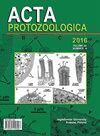Ultrastructure and Phylogeny of Pleistophora beebei sp. nov. (Microsporidia) Infecting the Amazonian Teleostean Brachyhypopomus beebei (fam. Hypopomidae)
IF 1.5
4区 生物学
Q4 MICROBIOLOGY
引用次数: 2
Abstract
A new microsporidian, Pleistophora beebei sp. nov., parasitizing the freshwater benthopelagic teleostean fish Brachyhypopomus beebei Schultz, 1944 (fam. Hypopomidae) collected from the Amazon River is described based on molecular and morphological studies. The parasite develops in the skeletal muscle of the abdominal cavity, forming a whitish cyst-like containing several groups of two types of spores (macrospores and microspores), which were observed in close contact with the myofibrils. Small groups of macrospores (ovoid elongate, tapering more anteriorly than posteriorly and measuring about 7.8 ± 0.4 × 4.7 ± 0.2 µm) were observed among the numerous microspores (lightly pyriform to ellipsoidal with rounded ends, measured about 4.7 ± 0.3 × 2.8 ± 0.4 µm). Both types of spores possessed a single large posterior vacuole containing flocculent material. The ultrastructural aspects observed, together with the formation of a cyst-like, suggest that the parasite belongs to the genus Pleistophora. This taxonomic positioning was confirmed by the molecular analysis of the SSU rRNA gene and Maximum-likelihood (ML) inference. Comparison to similar species previously described, recognized this as a new species, herein named Pleistophora beebei sp. nov.侵染亚马逊网骨鱼的beebepleistophora sp. 11 . (Microsporidia)的超微结构和系统发育。Hypopomidae)
一种新的寄生在淡水底栖硬骨鱼上的微孢子虫,beebei Pleistophora sp. nov。根据分子和形态学的研究,对亚马逊河中收集的小虫进行了描述。寄生虫在腹腔骨骼肌中发育,形成白色的囊状,其中含有两种类型的孢子(大孢子和小孢子),它们与肌原纤维密切接触。在大量的小孢子(微梨形至椭球形,端部为圆形,约4.7±0.3 × 2.8±0.4µm)中观察到小群的大孢子(卵球形,前端锥形大于后方,尺寸约7.8±0.4 × 4.7±0.2µm)。两种类型的孢子都具有一个大的后液泡,其中含有絮状物质。观察到的超微结构以及囊状结构的形成表明该寄生虫属于Pleistophora属。SSU rRNA基因的分子分析和最大似然(ML)推断证实了这一分类定位。与前人描述的相似种比较,认定为新种,命名为Pleistophora beebei sp. nov。
本文章由计算机程序翻译,如有差异,请以英文原文为准。
求助全文
约1分钟内获得全文
求助全文
来源期刊

Acta Protozoologica
生物-微生物学
CiteScore
2.00
自引率
0.00%
发文量
8
审稿时长
>12 weeks
期刊介绍:
Acta Protozoologica - International Journal on Protistology - is a quarterly journal that publishes current and comprehensive, experimental, and theoretical contributions across the breadth of protistology, and cell biology of Eukaryote microorganisms including: behaviour, biochemistry and molecular biology, development, ecology, genetics, parasitology, physiology, photobiology, systematics and phylogeny, and ultrastructure. It publishes original research reports, critical reviews of current research written by invited experts in the field, short communications, book reviews, and letters to the Editor.
 求助内容:
求助内容: 应助结果提醒方式:
应助结果提醒方式:


